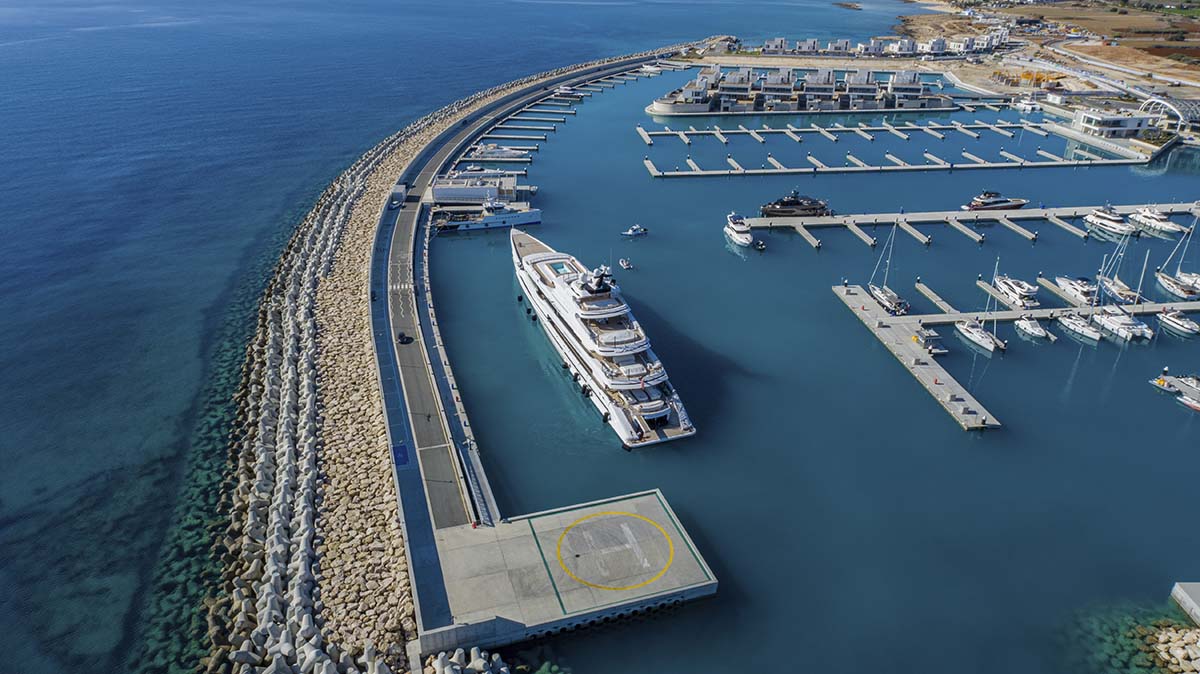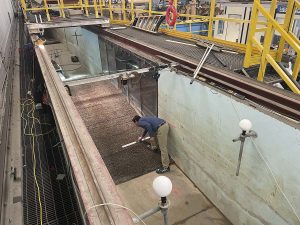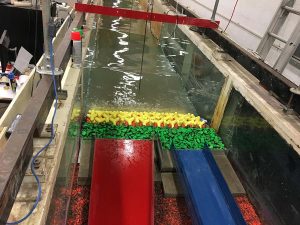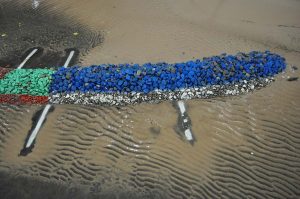
Re-engineering Breakwaters for Climate Change
Published on August 14, 2025Except for the lucky harbors that are naturally sheltered, breakwaters have been a key part of marina design since the time of the ancient Greeks and Phoenicians. Since these ancient breakwaters were built when the sea level was about 2 feet lower than today, almost all of them are underwater or irreparably damaged. Deeper waters exposed these breakwaters to larger waves; since wave forces hit with a power of three to the wave height, even a small increase in wave heights can destabilize a breakwater designed for different historic conditions.
Sea-level rise is currently accelerating due to climate change. The larger waves that form in deeper water threaten to undermine the stability of modern breakwaters much faster than they did in ancient port structures. This rapid change is also undermining our assumptions about the potential impacts of future storms and waves. Breakwaters have typically been designed to resist extreme environmental conditions that could be encountered once or twice during a marina’s service lifetime. Climate change introduces uncertainty into the magnitude and frequency of extreme environmental conditions, posing new difficulties for designing or restoring breakwaters as well as managing changes in sediment transport and erosion.

Given the large capital costs required, breakwaters need to be designed and built for the long haul. Asking the right questions and understanding how historic best practices need to be modified are essential to engineering a breakwater for effective protection and life-cycle performance in response to climate change.
Recalculating Extreme Conditions and Risk
The expected sea-level-rise scenarios from the International Panel for Climate Change (IPCC AR6) are 2 to 4 feet by the year 2100, depending on the relative increase in atmospheric carbon levels. Sea-level measurements have confirmed the predicted global trend in rising levels, with satellite readings measuring an accelerated rate of increase over the past three decades. This increase was due to thermal expansion caused by higher water temperatures as well as more rapid melting of glaciers and ice caps.
The design conditions for breakwaters are typically based on a statistical analysis of extreme historic events. Engineers analyze site-specific information on historic waves, winds, water levels and sediment to calculate storm events with return periods of 50 or 100 years and to set design conditions for the marina’s breakwaters. At least 20 years of historic wave-climate information is recommended to establish effective design parameters.
Climate change poses a major challenge to this process, since historic data can’t help in determining changing future conditions. In addition to higher water levels and waves, storms are projected to become larger and more frequent, and to expose sites to unprecedented impacts, e.g. waves coming from historically uncommon directions.

Changes we’ve already seen include large swell storms that travel across the Pacific, causing coastal erosion and damage in California and wreaking havoc in South America. We’ve also seen an increasing number and intensity of hurricanes in the North Atlantic.
The unprecedented rapid rise in water levels in the Great Lakes, which peaked in 2020, has also been linked to climate change. These historic high-water levels caused severe damage and erosion along thousands of miles of coastline, with the increased near-shore wave heights inflicting high levels of damage even during a one-year return period storm. Several climate studies predict a future increase in precipitation in the Upper Midwest, with models showing the potential for even higher Great Lakes water levels than those experienced in 2020.
Recalculating Cost and Risk Tolerance
This potential for increased future vulnerability needs to be looked at when designing or adapting a marina’s breakwater structures. While no one can afford to overbuild a breakwater, the costs of underbuilding could be staggering. Anticipating and planning for a range of plausible extreme scenarios is the best way to manage future risk. The critical factor is the adaptability and resilience of the breakwater itself.
The recently built Ayia Napa Marina in Cyprus provides a highly successful example of a resilient multi-use breakwater. It not only protects the marina basin, but integrates mega-yacht mooring facilities, a comfort station building and a service dock with its own helipad.
Physical model tests conducted for the Ayia Napa Marina breakwater design determined that a berm of large stone behind the interlocking tetrapods would eliminate future overtopping risks, allowing the breakwater to reach its full multiuse potential.
Climate change considerations played a key role in breakwater design, with a multidisciplinary team of coastal engineers, marina experts and architects involved throughout the entire design and construction process. In addition to providing the necessary protection for the basin, roadway and buildings, the final design needed to be as low profile as possible to avoid blocking the highly marketable views of the Mediterranean from inland development.
Our engineering team tested future scenarios for increased water levels, winds and waves through extensive numerical and physical modeling, evaluating wave penetration, stability and overtopping performance for different breakwater design configurations. This resulted in the design of an above-water, 10-meter-wide berm of large armor stone to account for potential overtopping impacts during extreme storms. This unique approach not only lowered the breakwater’s height; it also allowed the inner part of the breakwater to remain safe for mega-yacht mooring even under extreme future-climate-change scenarios.

This wider but shorter structure lowered costs by several million euros compared to a more typical tall-and-narrow design. While the breakwater still represented one fifth of the project’s total cost, the care taken during the planning and design phases maximized the structure’s use, adaptability and return on investment.
Meeting Public Expectations
Observing new trends in extreme storm and wave events also provides insight into possible future climate scenarios and allows engineers to develop more resilient solutions. At the same time, people are resistant to large protective infrastructure that blocks views and direct access to the water, compromises natural shoreline character and can interfere with local ecology and sediment movement. Engineers must find innovative new ways to balance resilient coastal protection with the public’s preference for natural shorelines.
Such was the case when Lake Michigan reached record-high water levels in 2020. Many areas along the coast were hit with massive flooding and coastal erosion, resulting in the need for emergency measures as well as longer-term solutions to shore up vulnerable beaches and shoreline protection systems.
To protect a vulnerable park on Lake Michigan, a softer and more accessible alternative breakwater solution was developed and tested on the natural cobble beaches of the Great Lakes. The resulting dynamic revetment self-adapts to increased water levels, reshaping itself in response to storm conditions. The extensive large-scale physical modeling carried out for this design established new guidelines for this lower profile, high-performance structure that can be applied in a variety of coastal conditions.
For less developed coastal areas facing accelerating erosion, letting nature take its course is no longer a viable option – but a more natural approach can be. Illinois Beach State Park, the final remaining undeveloped lakefront on Illinois’ Lake Michigan coast, was facing severe coastal erosion that was increasing due to higher water levels. A series of submerged and low-profile offshore breakwater structures were designed and constructed to protect this threatened nature preserve and its restored public beach.

Three-dimensional physical modeling allowed for complete analysis of the complex wave and sediment interactions around the proposed design for Illinois Beach State Park.
The design process used three-dimensional physical modeling to evaluate performance, providing better understanding of the complex wave-sediment dynamics. A multidisciplinary team including biologists and ecologists integrated avian and aquatic habitat features within and around the breakwaters, including restored spawning and nesting areas that had been lost to coastal erosion. The unique and award-winning plan and design features 22 breakwaters protecting more than 4 miles of shoreline, preserving natural character and providing lasting environmental benefits.
While the magnitude and frequency of future storms that breakwaters will encounter are not entirely clear, engineering as it’s typically been done won’t be a viable option in many locations. For marina owners and operators, the future of your facility depends on getting the design right. By utilizing an adaptive approach with the many advanced tools at our disposal, engineers can design more resilient breakwaters that manage risk while adding long-term value to a marina.
Mauricio Wesson, PE is a coastal and civil engineer with SmithGroup. He can be contacted at mauricio.wesson@smithgroup.com.
| Categories | |
| Tags |






